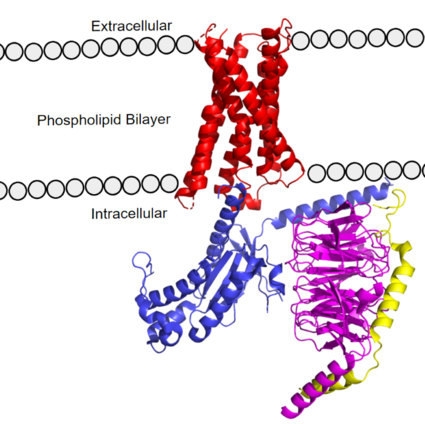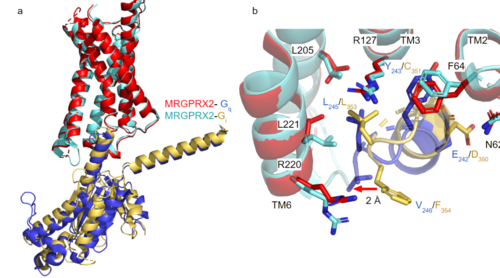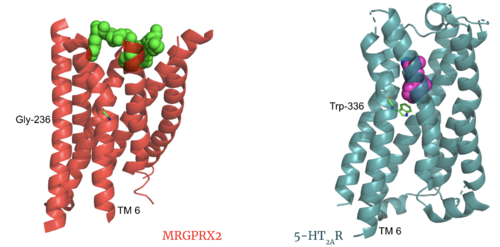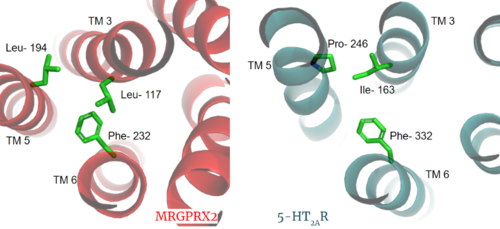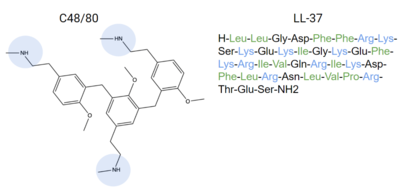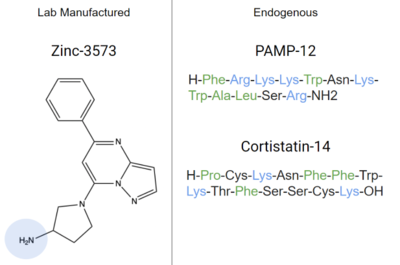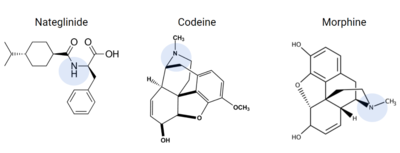Sandbox Reserved 1700
From Proteopedia
(Difference between revisions)
| Line 109: | Line 109: | ||
=== Ligands === | === Ligands === | ||
| - | MRGPRX2 binds a wide range of small molecule and peptide ligands. These ligands have positively charged regions which can interact with the negative binding pocket, sub-pocket 1. Some of these larger ligands also have a hydrophobic region which can interact with sub-pocket 2. MRGPRX2 is activated by [https://pubchem.ncbi.nlm.nih.gov/compound/118797323 C48/80]<ref name="Yang">PMID: 34789875</ref><ref name="Cao">PMID: 34789874</ref> and LL-37 <ref name= "Dondalska" />, among other endogenous inflammatory chemicals. | + | MRGPRX2 binds a wide range of small molecule and peptide ligands. These ligands have positively charged regions which can interact with the negative binding pocket, sub-pocket 1. Some of these larger ligands also have a hydrophobic region which can interact with sub-pocket 2. MRGPRX2 is activated by [https://pubchem.ncbi.nlm.nih.gov/compound/118797323 C48/80]<ref name="Yang">PMID: 34789875</ref><ref name="Cao">PMID: 34789874</ref> and [https://en.wikipedia.org/wiki/Cathelicidin LL-37]<ref name= "Dondalska" />, among other endogenous inflammatory chemicals. |
[[Image:Endogenous_ligands.png|400px|center|thumb|'''Figure 6.''' Endogenous MRGPRX2 ligands with positive regions in blue and hydrophobic regions in green. C48/80 and LL-37 are both released by the body as an allergic reaction response<ref name= "Dondalska">PMID: 33101278</ref>. These compounds can bind to MRGPRX2 and activate it, explaining how itching is a side effect of allergic reactions.]] | [[Image:Endogenous_ligands.png|400px|center|thumb|'''Figure 6.''' Endogenous MRGPRX2 ligands with positive regions in blue and hydrophobic regions in green. C48/80 and LL-37 are both released by the body as an allergic reaction response<ref name= "Dondalska">PMID: 33101278</ref>. These compounds can bind to MRGPRX2 and activate it, explaining how itching is a side effect of allergic reactions.]] | ||
| - | Other endogenous compounds that share similar characteristics of these ligands are [https://pubchem.ncbi.nlm.nih.gov/compound/95882507 Zinc-3573], [https://pubchem.ncbi.nlm.nih.gov/compound/PAMP-12-_human_-porcine#section=Structures PAMP-12], and [https://pubchem.ncbi.nlm.nih.gov/compound/44208884 Cortistatin-14]. These molecules are known agonists of MRGPRX2 and bind similarly to sub-pockets 1 and 2. | + | Other endogenous compounds that share similar characteristics of these ligands are [https://pubchem.ncbi.nlm.nih.gov/compound/95882507 Zinc-3573], [https://pubchem.ncbi.nlm.nih.gov/compound/PAMP-12-_human_-porcine#section=Structures PAMP-12], and [https://pubchem.ncbi.nlm.nih.gov/compound/44208884 Cortistatin-14] ('''Figure 7'''). These molecules are known [https://en.wikipedia.org/wiki/Agonist agonists] of MRGPRX2 and bind similarly to sub-pockets 1 and 2. |
An endogenous peptide agonist, <scene name='90/904306/C-14_in_site/4'>Cortistatin-14</scene> models these interactions, binding to sub-pocket 1 through LYS-3 and sub-pocket 2 through hydrophobic interactions. | An endogenous peptide agonist, <scene name='90/904306/C-14_in_site/4'>Cortistatin-14</scene> models these interactions, binding to sub-pocket 1 through LYS-3 and sub-pocket 2 through hydrophobic interactions. | ||
[[Image:Agonists - Copy.png|400px|center|thumb|'''Figure 7.''' Agonists of MRGPRX2 due to their structural similarities to known ligands. Positive regions shown in blue and hydrophobic regions in green. Cortistatin-14, PAMP-12, and Zinc-3573 are all known to bind to MRGPRX2 with high affinity, and inhibit mast cell degranulation<ref name="Yang">PMID: 34789875</ref><ref name="Cao">PMID: 34789874</ref>]] | [[Image:Agonists - Copy.png|400px|center|thumb|'''Figure 7.''' Agonists of MRGPRX2 due to their structural similarities to known ligands. Positive regions shown in blue and hydrophobic regions in green. Cortistatin-14, PAMP-12, and Zinc-3573 are all known to bind to MRGPRX2 with high affinity, and inhibit mast cell degranulation<ref name="Yang">PMID: 34789875</ref><ref name="Cao">PMID: 34789874</ref>]] | ||
Revision as of 20:16, 18 April 2022
MRGPRX2 Human Itch G-Protein Coupled Receptor (GPCR)
| |||||||||||
References
- ↑ Tuteja N. Signaling through G protein coupled receptors. Plant Signal Behav. 2009 Oct;4(10):942-7. doi: 10.4161/psb.4.10.9530. Epub 2009, Oct 14. PMID:19826234 doi:http://dx.doi.org/10.4161/psb.4.10.9530
- ↑ Hauser AS, Attwood MM, Rask-Andersen M, Schioth HB, Gloriam DE. Trends in GPCR drug discovery: new agents, targets and indications. Nat Rev Drug Discov. 2017 Dec;16(12):829-842. doi: 10.1038/nrd.2017.178. Epub, 2017 Oct 27. PMID:29075003 doi:http://dx.doi.org/10.1038/nrd.2017.178
- ↑ 3.0 3.1 3.2 Porebski G, Kwiecien K, Pawica M, Kwitniewski M. Mas-Related G Protein-Coupled Receptor-X2 (MRGPRX2) in Drug Hypersensitivity Reactions. Front Immunol. 2018 Dec 20;9:3027. doi: 10.3389/fimmu.2018.03027. eCollection, 2018. PMID:30619367 doi:http://dx.doi.org/10.3389/fimmu.2018.03027
- ↑ 4.0 4.1 4.2 4.3 4.4 4.5 4.6 Dondalska A, Ronnberg E, Ma H, Palsson SA, Magnusdottir E, Gao T, Adam L, Lerner EA, Nilsson G, Lagerstrom M, Spetz AL. Amelioration of Compound 48/80-Mediated Itch and LL-37-Induced Inflammation by a Single-Stranded Oligonucleotide. Front Immunol. 2020 Sep 30;11:559589. doi: 10.3389/fimmu.2020.559589. eCollection, 2020. PMID:33101278 doi:http://dx.doi.org/10.3389/fimmu.2020.559589
- ↑ 5.0 5.1 5.2 5.3 5.4 5.5 5.6 McNeil BD, Pundir P, Meeker S, Han L, Undem BJ, Kulka M, Dong X. Identification of a mast-cell-specific receptor crucial for pseudo-allergic drug reactions. Nature. 2015 Mar 12;519(7542):237-41. doi: 10.1038/nature14022. Epub 2014 Dec 17. PMID:25517090 doi:http://dx.doi.org/10.1038/nature14022
- ↑ 6.00 6.01 6.02 6.03 6.04 6.05 6.06 6.07 6.08 6.09 6.10 Cao C, Kang HJ, Singh I, Chen H, Zhang C, Ye W, Hayes BW, Liu J, Gumpper RH, Bender BJ, Slocum ST, Krumm BE, Lansu K, McCorvy JD, Kroeze WK, English JG, DiBerto JF, Olsen RHJ, Huang XP, Zhang S, Liu Y, Kim K, Karpiak J, Jan LY, Abraham SN, Jin J, Shoichet BK, Fay JF, Roth BL. Structure, function and pharmacology of human itch GPCRs. Nature. 2021 Dec;600(7887):170-175. doi: 10.1038/s41586-021-04126-6. Epub 2021, Nov 17. PMID:34789874 doi:http://dx.doi.org/10.1038/s41586-021-04126-6
- ↑ 7.0 7.1 7.2 7.3 7.4 7.5 7.6 7.7 7.8 Yang F, Guo L, Li Y, Wang G, Wang J, Zhang C, Fang GX, Chen X, Liu L, Yan X, Liu Q, Qu C, Xu Y, Xiao P, Zhu Z, Li Z, Zhou J, Yu X, Gao N, Sun JP. Structure, function and pharmacology of human itch receptor complexes. Nature. 2021 Dec;600(7887):164-169. doi: 10.1038/s41586-021-04077-y. Epub 2021, Nov 17. PMID:34789875 doi:http://dx.doi.org/10.1038/s41586-021-04077-y
- ↑ Kamato D, Thach L, Bernard R, Chan V, Zheng W, Kaur H, Brimble M, Osman N, Little PJ. Structure, Function, Pharmacology, and Therapeutic Potential of the G Protein, Galpha/q,11. Front Cardiovasc Med. 2015 Mar 24;2:14. doi: 10.3389/fcvm.2015.00014. eCollection, 2015. PMID:26664886 doi:http://dx.doi.org/10.3389/fcvm.2015.00014
- ↑ Trzaskowski B, Latek D, Yuan S, Ghoshdastider U, Debinski A, Filipek S. Action of molecular switches in GPCRs--theoretical and experimental studies. Curr Med Chem. 2012;19(8):1090-109. doi: 10.2174/092986712799320556. PMID:22300046 doi:http://dx.doi.org/10.2174/092986712799320556
- ↑ Olivella M, Caltabiano G, Cordomi A. The role of Cysteine 6.47 in class A GPCRs. BMC Struct Biol. 2013 Mar 15;13:3. doi: 10.1186/1472-6807-13-3. PMID:23497259 doi:http://dx.doi.org/10.1186/1472-6807-13-3
- ↑ Gonzalez-Rey E, Chorny A, Robledo G, Delgado M. Cortistatin, a new antiinflammatory peptide with therapeutic effect on lethal endotoxemia. J Exp Med. 2006 Mar 20;203(3):563-71. doi: 10.1084/jem.20052017. Epub 2006 Feb, 21. PMID:16492802 doi:http://dx.doi.org/10.1084/jem.20052017
